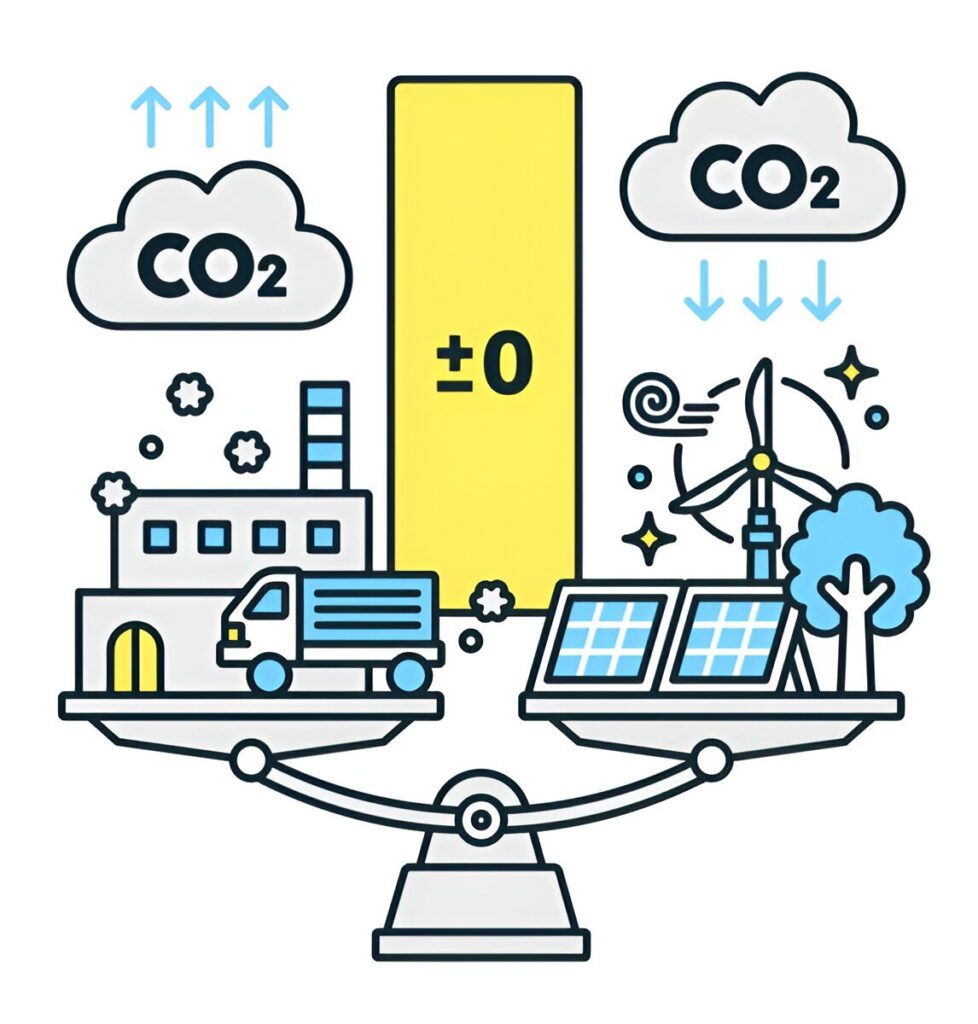Decarbonizing high carbon emissions to 100% is challenging. However, this challenge must be taken up to avoid the consequences of climate change.
What is decarbonization
Decarbonization refers to reducing carbon dioxide (CO2) emissions produced by human activities, especially from burning fossil fuels like coal, natural gas, and oil.
Decarbonization aim to limit the negative impacts of climate change by transitioning to cleaner energy sources, improving energy efficiency, and adopting carbon-reducing technologies. As one of the main contributors to global warming, CO2 is primarily released through industrial activities, transportation, and energy production.

Reducing carbon levels takes policy measures at local, national, and international levels in the whole world, including the United States. Global agreements such as the Paris Agreement aim to limit global temperature rise to well below 1.5°C net-zero emissions by 2050. Net-zero means that all greenhouse gas emission presently produced is balanced by the same amount of emissions removed from atmosphere. In 2030 carbon emission need to cut down 50%. This requires a collective commitment from governments, businesses, and individuals to reduce carbon footprints and foster a sustainable, low-carbon future.
Why is decarbon is important for us
Decarbonization, often used interchangeably with decarburization in some contexts, is a process that involves the reduction of carbon content in steel and other metals, which is important for both industrial and environmental reasons.
Here are several reasons why decarburization is critically important:
1. Mitigating Climate Change: Carbon dioxide (CO2) emissions from burning fossil fuels are the primary drivers of climate change. By reducing CO2 emissions, decarburization can help to lower global warming by 1.5 centigrade, reduce extreme weather events, and mitigate the impact of rising sea levels. Global warming’s consequences would be very dangerous, it’s a Deadly threat to the health and safety of the planet.
2. Public Health: Carbon emissions are often accompanied by pollutants like particulate matter, sulfur, and nitrogen oxides, which contribute to respiratory diseases, heart conditions, and other health problems. Decarburization can lead to cleaner air, improving public health and reducing healthcare costs associated with pollution.
3. Energy Transition: Encourages the use of fossil fuels. Although, have higher initial installation costs but ensure sustainability and energy security due to their long-term use.
4. Sustainable Economic Growth: The problem of uninterrupted energy supply is one of the most important issues in the world. Especially for the least developed countries. Decarburization can work in the development of renewable energy, advanced energy technologies, electric vehicles and sustainable industries. Especially for power generation, According to the 2023 study, 60% of the world’s electricity is generated from fossil fuels. And 60% of the total electricity generation in the United States is produced from fossil fuels. This continues to play a huge role in GHG.
Who is responsible for high carbon emission?

Carbon emissions are generated by various sectors of society, and responsibility for these emissions is shared by multiple entities, including governments, industries, businesses, and individuals. Here’s a breakdown of who is responsible for carbon emissions:
1. Industrial decarbonization
Energy Production: The largest contributor to carbon emissions is the energy sector, particularly the burning of fossil fuels like coal, oil, and natural gas for electricity and heat. The world’s population is increasing day by day, and the use of electricity is increasing. In addition to ensuring electricity consumption for this growing population, it is essential to reduce carbon emissions from the electricity produced. Electricity generation is responsible for 30% of global carbon emissions. Because 60% of the world’s total electricity production is from fossil fuels, which needs to be replaced with renewable energy. However, as time goes by, the cost of electricity generation from renewable energy sources is decreasing. Due to which electricity generation using renewable energy is gradually increasing. In particular, the price of solar energy has decreased by about 35-40 in the last 10-12 years. In addition, the cost of batteries has also decreased by more than half compared to 2015. This is playing a big role in the use of solar power. The United States is planning to increase electricity generation from 21.3% renewable energy to 80% by 2030. And has set a goal of generating electricity from 100% renewable energy by 2035. Fossil fuel plants can be kept as a bake-off for renewable power generation, but advanced carbon emission capture should be used for this. For example, furnace well-based plants should use flue gas desulfurization (FGD). About 90% of the ash emitted from coal-fired power plants needs to be retrofitted. There is no alternative to energy conservation in power generation. About half of the energy in power generation plants is wasted; this waste must be put to use, which will result in an increase in the production efficiency of the plant.
Manufacturing and Industry: Steel production, cement manufacturing, chemical production, and other heavy industries are responsible for substantial emissions, largely due to energy-intensive processes and the use of fossil fuels in production. 30 percent of the world’s total carbon emissions come from industrial plants. About 30% of the United States, which is about 6,343 million metric tons of CO2 equivalents, is emitted from industrial plants. This is the second highest emission in the world. Decarbonizing this huge amount of carbon will be a very difficult step. Because steel, cement, chemical production requires a lot of heat, which is about 1,500 degrees Celsius. To generate such a large amount of heat, it can be easily done from fossil fuels. But if electric furnaces are used, then the furnaces will have to be changed and the cost will be much higher than fossil fuels. This will be economically challenging for the industry. To reduce the carbon emissions of this sector, it is necessary to invent innovative technologies, which will make these huge heat furnaces work efficiently and efficiently. In addition, the waste management of this industry must be improved, so that waste heat can be utilized through cogeneration to increase production efficiency. Biomass, wood, coal can be used in cement, steel, and chemical production.
Transportation: The transportation sector—spanning road, air, rail, and shipping—also contributes heavily to emissions, especially from gasoline and diesel-powered vehicles, planes, and ships. This sector is a significant part of global emissions. The total carbon emissions from road, Ship, and air transport in the world each year are eight billion metric tons, which is increasing at a rate of 3% per year since 2021. 29% of the total carbon emissions in the United States come from the transportation sector, the third largest sector. A plan has been taken to halve emissions by 2030 and zero emissions by 2050. All cars are working to become electric vehicles or hydrogen fuel cell vehicles using renewable fuels. To reduce carbon emissions, some plans should be taken, such as: bringing more electric vehicles on the road, further expanding charging stations, and increasing vehicle efficiency can play an important role. In addition, reducing the use of personal cars and increasing public transportation, car sharing, and expanding rail. The aviation sector is responsible for 2.1 percent of the world’s total carbon emissions. The carbon emissions of this aviation sector can be reduced through well-organized and advanced planning. For example: using direct flights, maintaining optimal speeds, using alternative fuels such as hydrogen. Aviation is one of the sectors that is difficult to decarbonize. The fuel for marine vehicles is mainly furnace oil or heavy fuel. These marine vehicles are responsible for 2.5 percent of the world’s total carbon emissions. Millions of marine vehicles operate every year. These carbon emissions can be reduced by using advanced technology vehicles and co-generating heat. However, alternative systems for this sector are difficult because the cost of heavy fuel is very cheap.
2. Businesses and Corporations
Private businesses, especially those in high-emission sectors like automotive manufacturing, construction, and agriculture, have a direct role in emissions. Companies that rely on fossil fuels for energy or as raw materials contribute to carbon emissions.
Companies also indirectly contribute to emissions through their supply chains and products. For example, large retailers or tech companies that rely on factories in carbon-intensive regions can contribute to emissions through their demand for goods and services that depend on carbon-heavy processes.
3. Consumers and Individuals.
Energy Use in Homes: Individuals contribute to emissions by using electricity and heating, particularly if the energy comes from fossil fuels. Carbon-intensive electricity sources like coal and natural gas increase personal carbon footprints.
Consumption Habits: Individuals contribute indirectly through their consumption choices. Products with a high carbon footprint, such as meat, dairy, and certain imported goods, contribute to carbon emissions due to their production and transportation processes.
4. Agriculture
The agriculture sector, including farming, livestock, and deforestation, also generates a significant amount of carbon emissions. Agriculture accounts for 1 percent of CO2 emissions. The agricultural sector is responsible for 9.4 percent of total carbon emissions in the United States. Soil management, fertilizer application, and livestock are largely responsible for this. Various agricultural soil management practices increase the amount of nitrogen, resulting in N20 emissions. More than half of agricultural carbon emissions are primarily due to various practices to increase soil fertility. Livestock also emits carbon. The normal digestive process of animals produces methane (CH4), which causes greenhouse gas emissions from the agricultural sector. Fertilizer management is responsible for 14 percent of total carbon emissions from the agricultural sector in the United States.
5. Developed vs. Developing Nations
Developed Countries: Historically, developed countries like the United States, the European Union, and Japan have been the largest contributors to carbon emissions. Their industrialization over the past century has led to higher cumulative emissions.
Developing Countries: While developing countries, like China and India, have seen rapid industrialization in recent decades, their per capita emissions are often lower than those of developed nations. However, they are still responsible for a growing share of global emissions due to population size and economic growth.
What Challenges for decarbon?
Considering the current technology and development, it is possible to achieve net zero by 2050. However, this requires international cooperation, including our behavior, policy implementation. However, decarburization of the power generation and transportation sectors will be very challenging. The main reason for this is the huge amount of investment in these sectors by 2050. Although the decarburization plan in this sector is profitable in the long term, it may require spending about 275 trillion US dollars in the short term. Various studies have shown that to completely decarbonize each of the power generation and transportation sectors, 5 to 10 times more electricity will be required. Due to which consumers will have to pay for this additional energy cost. Consumers will also have to spend extra money due to the development of grid networks and the expansion of renewable energy, although the production costs for renewable energy will be lower. “People have invested heavily in fossil fuels to power their homes and cars, so these people will only use renewable energy when it is cheaper and more readily available than their fossil fuels,” said Steve Cohen, a professor at Columbia University and director of the Sustainable Policy and Management Research Program.
1. Technological Barriers
- Limited Clean Energy Infrastructure: Transitioning to renewable energy sources like wind, solar, and hydropower requires substantial upgrades to the grid and storage technologies, which are still evolving.
- Energy Storage Issues: Renewables such as solar and wind are intermittent, making reliable energy storage solutions (like batteries) crucial. Current storage technology is expensive and not yet sufficient to meet large-scale demand.
- Carbon Capture and Storage (CCS): While CCS technology can mitigate emissions from fossil fuel use; it’s still in its early stages. It’s expensive, energy-intensive, and its long-term effectiveness is not fully proven.
2. Economic Costs
- High Initial Investment: Decarburization requires massive investment in clean energy infrastructure, R&D, and retrofitting existing industries. This can be a significant barrier for developing economies or countries with limited resources.
- Disruption of Industries: Traditional industries such as fossil fuel extraction, petrochemicals, and automotive manufacturing may face job losses and financial instability as they transition away from carbon-intensive processes. Ensuring a just transition for workers is a major concern.
- Energy Prices: The shift to renewables can initially increase energy prices due to the cost of new technologies, which could disproportionately affect lower-income households and developing countries.
3. Political and Policy Challenges
- Lack of Political Will: In many regions, political leaders may prioritize short-term economic gains over long-term environmental sustainability. This can result in delays or rollback of decarburization policies.
- Policy Inconsistency: Changes in government or political ideologies can lead to inconsistent environmental policies, making it difficult for industries to plan long-term investments in decarburization.
- International Coordination: Climate change is a global issue, and decarburization requires international cooperation. Disparities in economic development, national interests, and historical emissions make it challenging to create a unified global response.
4. Social and Behavioral Factors
- Public Resistance: Many people are resistant to change due to comfort with the current system or lack of awareness about the urgency of the situation. For example, transitioning away from fossil fuels may be seen as disruptive or inconvenient.
- Lifestyle Changes: Achieving net-zero emissions requires changes in consumption patterns, such as reduced meat consumption, sustainable transportation choices, and energy-efficient living. These changes can be difficult to implement on a large scale due to societal inertia.
- Equity and Access: In some regions, access to clean technologies like electric vehicles and solar energy is limited. Ensuring that decarburization is equitable and accessible to all people is a significant challenge.
5. Industrial and Sector-Specific Challenges
- Hard-to-Abate Sectors: Some industries, such as heavy manufacturing (steel, cement), aviation, and shipping, are difficult to decarbonize due to the high energy intensity and unique requirements of these sectors.
- Agriculture and Land Use: Agriculture is a major source of greenhouse gas emissions, particularly methane from livestock and nitrogen from fertilizers. Decarbonizing this sector involves changing agricultural practices, which can be challenging for farmers who rely on traditional methods.
6. Global Emissions Growth
- Emerging Economies: Developing countries are rapidly industrializing, and while they have lower per capita emissions, their overall emissions are rising. Supporting these nations with financial resources and technology transfers for decarburization is crucial but challenging.
- Increased Demand for Energy: As global populations grow and standards of living rise, overall energy demand continues to increase. Meeting this demand sustainably while reducing emissions is a complex balancing act.
7. Supply Chain and Resource Limitations
- Raw Material Shortages: Many clean technologies, such as electric vehicles and renewable energy systems, rely on critical raw materials like lithium, cobalt, and rare earth elements. The demand for these materials is expected to rise sharply, potentially leading to supply shortages or geopolitical conflicts over resources.
- Recycling and Circular Economy: Decarburization requires efficient systems for recycling and reusing materials, but current global recycling rates are often inadequate. A circular economy model needs to be more widely adopted, which can be technically challenging.
8. Public and Private Sector Collaboration
Coordination between Stakeholders: The transition requires collaboration between governments, businesses, and civil society. Without cohesive action, efforts may be fragmented and ineffective. Public-private partnerships are essential but can be difficult to establish in a politically polarized environment.
What action taken by US for decarbonize
The U.S. has implemented a range of decarburization initiatives aimed at reducing greenhouse gas emissions and transitioning to a more sustainable, low-carbon economy. These initiatives are driven by both federal and state-level policies, as well as efforts from private sectors and local governments. Below are some of the key decarburization efforts in the U.S.:
1. IRA of 2022
The Inflation Reduction Act is a major federal initiative focused on addressing climate change and decarbonization. It includes significant investments in clean energy technologies, energy efficiency, and emissions reductions. Some notable components include:
- Tax Credits for Renewable Energy: The IRA provides expanded tax credits for renewable energy sources, such as wind, solar, and geothermal.
- Clean Energy Manufacturing: Incentives for clean energy manufacturing and infrastructure development, aiming to boost domestic production of renewable energy technologies and electric vehicles (EVs).
- Carbon Capture and Storage: The Act includes funding and incentives for technologies that capture and store carbon emissions, reducing overall emissions in sectors like heavy industry and fossil fuels.
- Electric Vehicle (EV) Incentives: Expands incentives for electric vehicle purchases and infrastructure (e.g., EV charging stations).
2. The Clean Power Plan (CPP) & Clean Energy Standards
The Clean Power Plan (which was proposed during the Obama administration) aimed to reduce carbon emissions from power plants by shifting from coal to cleaner energy sources like natural gas and renewables. While the Trump administration rolled back these regulations, efforts to adopt new rules are ongoing under the Biden administration, such as the Clean Energy Standard (CES), which seeks to decarbonize the electric grid.
The Biden Administration’s 100% Clean Energy Goal: The Biden administration has set a goal for the U.S. to reach a 100% clean energy grid by 2035, emphasizing renewable sources like wind, solar, and hydropower.
3. The Paris Agreement (Rejoining Under Biden Administration)
In 2021, President Biden rejoined the Paris Agreement, a global accord to limit global temperature rise and reduce emissions. The U.S. has committed to reducing its emissions by 50-52% below 2005 levels by 2030. This aligns with a broader international effort to meet the climate targets of the Paris Agreement.
4. Renewable Energy Expansion
The U.S. has significantly increased its investments in renewable energy, with both public and private sectors working to transition from fossil fuels to cleaner sources like wind, solar, and hydropower.
- Wind and Solar Growth: The U.S. has become one of the leading nations in wind and solar energy production. Wind energy is particularly prominent in the Midwest and offshore, while solar energy is expanding rapidly in states like California, Texas, and Arizona.
- Offshore Wind Projects: New offshore wind projects along the East Coast are being developed to meet renewable energy goals.
5. Electrification of Transportation
The U.S. is working to decarbonize the transportation sector, which is one of the largest sources of greenhouse gas emissions.
- Electric Vehicles (EVs): The Biden administration has set goals to significantly increase EV adoption, with targets for EVs to make up 50% of all new vehicle sales by 2030. Federal tax incentives, along with investments in charging infrastructure, are helping to make EVs more accessible.
- EV Charging Infrastructure: Investment in public and private EV charging infrastructure has been ramped up to support the adoption of electric vehicles.
6. Carbon Pricing and Markets
- Carbon Pricing: While there is no nationwide carbon tax, there are various proposals to introduce a national carbon tax or carbon trading markets to incentivize emissions reductions. Some states, like California, have established their own cap-and-trade systems to reduce carbon emissions from major polluters.
- State-level Cap-and-Trade Programs: Programs like California’s Cap-and-Trade Program and the Regional Greenhouse Gas Initiative (RGGI) in the Northeast allow companies to trade carbon allowances, which has incentivized reductions in emissions.
7. Green New Deal Proposals
The Green New Deal is a proposed framework aimed at addressing climate change through large-scale infrastructure investments. Though it has not been fully passed, it has been a source of inspiration for various federal and state-level policies that emphasize clean energy, decarbonizing the economy, and creating green jobs.
8. Energy Efficiency Programs
- Energy Efficiency Standards: U.S. regulatory bodies like the Department of Energy (DOE) have set stricter energy efficiency standards for appliances, buildings, and vehicles. These standards aim to reduce energy consumption and emissions across various sectors.
- Weatherization Assistance: The U.S. has increased investment in programs like the Weatherization Assistance Program (WAP), which helps low-income households reduce energy consumption by improving the energy efficiency of their homes.
9. Investment in Carbon Capture and Storage (CCS)
- Carbon Capture and Storage (CCS) is considered a critical technology for reducing emissions from industrial sources and fossil fuel plants. Several federal initiatives, like the Carbon Capture and Storage Tax Credit (45Q), incentivize the development and deployment of CCS technologies to capture carbon emissions and store them underground.
10. State-Level Initiatives
Many states are taking independent action to decarbonize and reduce their carbon footprints:
- California’s Leadership: California has been a leader in adopting stringent environmental standards and policies, including the California Air Resources Board (CARB) regulations and the state’s goal to transition to 100% clean energy by 2045.
- Northeast and Mid-Atlantic States: The Regional Greenhouse Gas Initiative (RGGI) is a carbon cap-and-trade program involving several northeastern states that limits emissions from power plants and generates revenue for further climate action.
11. Green Investment and Innovation
- Clean Energy Research and Development: The U.S. is investing in the research and development of new technologies like advanced nuclear power, hydrogen energy, and smart grids. The Department of Energy (DOE) is funding projects to develop these next-generation clean technologies to support decarbonization.
- Private Sector Investment: Major companies are committing to carbon neutrality and investing in renewable energy, electric vehicles, and other sustainable practices. For example, major corporations like Google, Amazon, and Microsoft have set ambitious carbon-neutral goals for their operations.
12. National Hydrogen Strategy
The U.S. is exploring hydrogen as a clean energy source that could be used for industrial processes, transportation, and power generation. The Hydrogen Hub Initiative seeks to develop regional hydrogen hubs to support the transition to a hydrogen economy.
Conclusion: To protect future generations from the disaster of high carbon emissions and to achieve a better and better life, net zero must be achieved by 2050. Every country, tribe, and nation in the world must come forward united. Otherwise, our existence will be in serious crisis.

